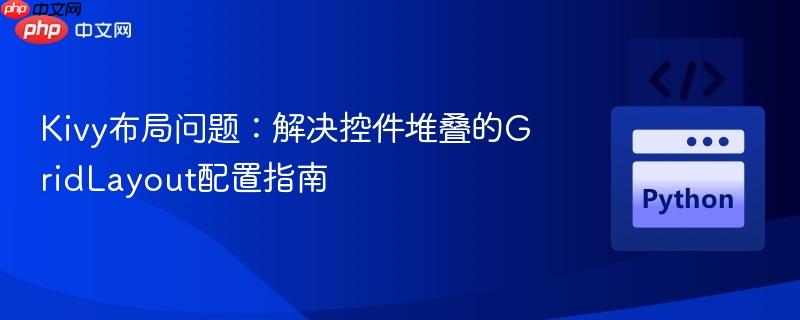
本文旨在解决kivy应用中`gridlayout`布局导致控件堆叠的常见问题。通过分析`gridlayout`的工作原理和kv语言的层级结构,我们将揭示问题根源在于根布局未正确配置`cols`或`rows`属性。文章将提供详细的解决方案,包括kv文件优化和完整的示例代码,帮助开发者构建结构清晰、功能正常的kivy用户界面。
Kivy是一个强大的Python GUI框架,它通过布局管理器(Layout Managers)来组织和定位用户界面中的各种控件(Widgets)。常见的布局管理器包括:
理解这些布局管理器的工作方式及其配置是构建响应式和美观Kivy界面的关键。
GridLayout是Kivy中用于创建网格状界面的布局管理器。它通过将子控件放置在预定义的行和列中来组织UI。要使GridLayout正常工作,最核心的配置就是指定其cols(列数)或rows(行数)属性之一。如果两者都未指定,或者只指定了一个但无法推断出另一个,GridLayout将无法正确计算子控件的位置和大小,从而导致所有控件堆叠在一起。
在Kivy中,通常推荐使用KV语言来定义UI结构,因为它提供了更清晰、更声明式的方式。当在KV文件中定义一个继承自GridLayout的自定义控件时,也必须在KV规则中为其设置cols或rows属性。
根据提供的代码,问题在于自定义的根控件MyRoot虽然在main.py中继承自GridLayout,但在aluminiummass.kv文件中,MyRoot的KV规则内部又嵌套了一个GridLayout,并且最外层的MyRoot本身并未配置cols或rows属性。
# main.py
class MyRoot(GridLayout): # MyRoot继承了GridLayout
def __init__(self):
super(MyRoot, self).__init__()# aluminiummass.kv
<MyRoot>:
# 这里MyRoot本身没有设置cols或rows
GridLayout: # MyRoot的第一个子控件是一个GridLayout
orientation: "lr-tb"
cols: 3 # 这个内部的GridLayout设置了cols
# ... 所有的Label, TextInput, Button都是这个内部GridLayout的子控件Kivy在运行时会发出警告信息,例如:
[WARNING] <__main__.MyRoot object at 0x...> have no cols or rows set, layout is not triggered.
这条警告明确指出,MyRoot实例(一个GridLayout)没有设置cols或rows,导致其布局机制未被触发。尽管内部的GridLayout设置了cols,但由于MyRoot这个父级布局没有正确配置,它无法正确地容纳其子控件(即那个内部的GridLayout),最终导致视觉上的混乱和堆叠。
核心问题: 当一个控件继承自GridLayout并在KV文件中作为根规则时,它自己必须定义cols或rows。嵌套的GridLayout是次要的,如果MyRoot本身就是网格布局,通常不需要再嵌套一个。
解决这个问题的关键在于:
通过这种方式,MyRoot将直接充当主网格布局,并根据其cols属性和子控件的顺序进行排列。如果需要更复杂的布局,可以考虑在MyRoot内部使用其他布局管理器(如BoxLayout、FloatLayout)来组合控件,而不是简单地嵌套一个同类型的GridLayout。
考虑到原代码中最高列索引为col: 3,这意味着总共有4列(0, 1, 2, 3)。因此,我们将MyRoot的cols设置为4。
<MyRoot>:
# 为MyRoot这个GridLayout设置列数
cols: 4
# 移除冗余的内部GridLayout,所有UI元素直接作为MyRoot的子控件
# 第一行
Label:
text: "Area:"
font_size: 26
bold: True
id: area
# GridLayout会自动按顺序填充,但如果需要精确控制,可以保留row/col
# 这里为了与原意保持一致,并演示GridLayout的布局能力,我们保留它们
row: 0
col: 0
TextInput:
multiline: False
font_size: 26
id: masahat
row: 0 # 调整为与Label在同一行
col: 1 # 调整为与Label在同一行
Button:
text: "Standard"
font_size: 26
bold: True
id: standard
on_press: root.standard()
row: 0
col: 2
Button:
text: "Nikoghadam"
font_size: 26
bold: True
id: nikoghadam
on_press: root.nikoghadam()
row: 0
col: 3
# 第二行
Label :
text: "Darsad:"
font_size: 26
bold: True
id: darsad_l
row: 1
col: 0
TextInput:
multiline: False
font_size: 26
id: darsad
row: 1
col: 1
Button:
text: "Hosein Momeni"
font_size: 26
bold: True
id: hosein_momeni
on_press: root.hosein()
row: 1
col: 2
Button:
text: "Ayazi"
font_size: 26
bold: True
id: ayazi
on_press: root.ayazi()
row: 1
col: 3
# 第三行
Button:
text: "Calculate"
font_size: 26
bold: True
id: calculate_button
on_press: root.calculate()
row: 2
col: 0
Button :
text: "AC"
font_size: 26
bold: True
id: clear_button
on_press: root.clear()
row: 2
col: 1
Button:
text: "Akhavan"
font_size: 26
bold: True
id: akhavan
on_press: root.akhavan()
row: 2
col: 2
Button:
text: "Kazemi"
font_size: 26
bold: True
id: kazemi
on_press: root.kazemi()
row: 2
col: 3
# 第四行
Label:
text: "Answer: "
font_size: 26
halign: "right"
valign: "middle"
bold: True
id: result_l
row: 3
col: 0
Label:
text: ""
font_size: 26
halign: "left"
valign: "middle"
bold: True
id: result_label
row: 3
col: 1
Button:
text: "Rasoli"
font_size: 26
bold: True
id: rasoli
on_press: root.rasoli()
row: 3
col: 2
Button:
text: "Hasanzade"
font_size: 26
bold: True
id: hasanzade
on_press: root.hasanzade()
row: 3
col: 3
# 第五行
Button:
text: "Darbahani"
font_size: 26
bold: True
id: darbahani
on_press: root.darbahani()
row: 4
col: 2 # 调整为第2列
Button:
text: "Mojtaba Rasoli"
font_size: 26
bold: True
id: mojtaba
on_press: root.m_rasoli()
row: 4
col: 3
# 第六行
Button:
text: "Bijani"
font_size: 26
bold: True
id: bijani
on_press: root.bizhani()
row: 5
col: 2
Button:
text: "Ali Karimi"
font_size: 26
bold: True
id: alikarimi
on_press: root.karimi()
row: 5
col: 3
# 第七行
Button:
text: "Mohammadi"
font_size: 26
bold: True
id: mohammadi
on_press: root.mohamadi()
row: 6
col: 2main.py中的代码无需修改,因为它已经正确地将MyRoot定义为一个GridLayout。
import kivy
from kivy.app import App
from kivy.uix.gridlayout import GridLayout
from kivy.uix.label import Label
from kivy.uix.button import Button
from kivy.uix.textinput import TextInput
# 移除未使用的导入以保持代码整洁
# from kivy.uix.floatlayout import FloatLayout
# from kivy.uix.boxlayout import BoxLayout
# from kivy.uix.widget import Widget
# from kivy.lang.builder import Builder
# from kivy.uix.layout import Layout
kivy.require('2.0.0')
# 将这些函数定义为MyRoot类的方法更符合面向对象的设计
# 但为了保持与原代码的最小改动,暂时维持函数形式,并在MyRoot中引用
# 注意:这些函数需要访问MyRoot的实例属性,因此它们应该作为MyRoot的方法,
# 并在调用时传递self。当前代码中,这些函数被定义在全局作用域,
# 但在KV中通过root.calculate()等方式调用时,root会自动作为self传递。
# 这是一个Kivy的特性,但在大型项目中,最好将相关逻辑封装在类中。
# 为了教程的完整性和规范性,我们将其重构为MyRoot的方法。
# 假设这些方法现在是MyRoot的成员方法。
class MyRoot(GridLayout):
# Kivy属性绑定
masahat = None
darsad = None
result_label = None
def __init__(self, **kwargs):
super(MyRoot, self).__init__(**kwargs)
# 在这里初始化绑定的属性,Kivy Builder会自动处理这些绑定
# 例如 self.ids.masahat 会引用到TextInput
# 实际的绑定是在KV文件中通过 `masahat: masahat` 完成的,
# 它们会作为MyRoot的属性被引用。
def calculate(self):
try:
a = float(self.masahat.text)
darsad_value_str = self.darsad.text
if darsad_value_str:
b = float(darsad_value_str)
c = a * (b / 100)
x = (a - c) * 2.7 # Assuming ro is constant
rounded_x = round(x, 2)
self.result_label.text = str(rounded_x)
else:
self.result_label.text = 'Enter Darsad Value'
except ValueError:
self.result_label.text = 'Invalid Input'
def clear(self):
self.masahat.text = ''
self.result_label.text = ''
self.darsad.text = ''
def set_darsad_value(self, value):
self.darsad.text = str(value)
# 以下是设置darsad值的便捷方法
def standard(self):
self.set_darsad_value(6)
def hosein(self):
self.set_darsad_value(21)
def akhavan(self):
self.set_darsad_value(15.84)
def rasoli(self):
self.set_darsad_value(13)
def bizhani(self):
self.set_darsad_value(27)
def mohamadi(self):
self.set_darsad_value(2.5)
def nikoghadam(self):
self.set_darsad_value(10)
def ayazi(self):
self.set_darsad_value(19)
def kazemi(self):
self.set_darsad_value(22)
def hasanzade(self):
self.set_darsad_value(13.5)
def m_rasoli(self):
self.set_darsad_value(2.5)
def karimi(self):
self.set_darsad_value(2.5)
def darbahani(self):
self.set_darsad_value(22)
class AluminiumMass(App):
def build(self):
return MyRoot()
if __name__ == '__main__':
AluminiumMass().run()
注意:
应用此修改后,当运行Kivy应用时,您将看到所有按钮、文本输入框和标签按照网格布局正确排列,不再出现堆叠现象。
Kivy中控件堆叠的问题,尤其是当使用GridLayout时,通常源于布局管理器自身配置的缺失。通过确保
以上就是Kivy布局问题:解决控件堆叠的GridLayout配置指南的详细内容,更多请关注php中文网其它相关文章!

每个人都需要一台速度更快、更稳定的 PC。随着时间的推移,垃圾文件、旧注册表数据和不必要的后台进程会占用资源并降低性能。幸运的是,许多工具可以让 Windows 保持平稳运行。

Copyright 2014-2025 https://www.php.cn/ All Rights Reserved | php.cn | 湘ICP备2023035733号